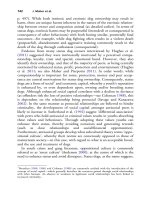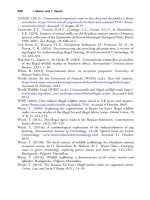The palgrave international handbook of a 285
Bạn đang xem bản rút gọn của tài liệu. Xem và tải ngay bản đầy đủ của tài liệu tại đây (41.47 KB, 1 trang )
282
K. Young
animal welfare organizations—the CHS and the ASPCA. These groups consult
with the Calgary Stampede throughout the year, and also regulate the Alberta
Animal Protection Act (2010)6 throughout the duration of the annual Stampede.
A number of publicly available sources explain the changing role that the CHS
has played in implementing these rule changes. For example, Thirty-six Ways
We’ve Improved Treatment of Stampede’s Animals (Cameron 2011) explains the
role that the CHS has played in enhancing animal welfare in this context. The
author, Patricia Cameron, Director of the CHS, explains the goals of the
‘partnership’ between the two organizations in the following way: ‘. . . to engage
in long-term relationship building, to foster dialogue, to mutually seek solutions
and understanding, to conduct solid research, to educate and to provide evidence-based recommendations’ (Cameron 2011, p. A11). Ultimately, this might
further legitimize the rules put forward by the Calgary Stampede because they
have been collaboratively and visibly agreed upon by an animal welfare organization. In addition to partnering with animal welfare organizations, the Calgary
Stampede has also partnered with Moore and Co., an equine veterinary practice,
which monitors the care and health of animals throughout the Stampede. Of
course, one of the paradoxical consequences of appearing to respond to animal
welfare is that concerns can be disregarded or put aside even when harm to
animals remains very real (see Beirne and South 2007).
Further, the Calgary Stampede has created two independent groups in its
pursuit of a more transparent and animal-friendly mandate—the ACAP and the
CSC. As outlined on the Calgary Stampede website, the role of such groups is to
‘ensure we set the highest standards for proper animal care.’ The CSC was
developed in 2008, just two years after the Calgary Stampede opted to develop its
own rodeo format (as opposed to continuing as a more broadly sanctioned rodeo
event). In an article written for Canadian Geographic, Dixon (2011) explains that
this group ‘ . . . developed a code of conduct and set stiff fines and penalties for
dangerous conduct jeopardizing the horses or drivers.’ The purpose of such fines
and penalties was to decrease (ideally eliminate) horse deaths which result from
avoidable accidents, such as those caused by driver error or track conditions. The
ACAP, made up of independent experts from various disciplinary backgrounds,
was developed in 2010, and was charged with ensuring that the Calgary
Stampede maintains robust animal care practices (see Calgary Stampede 2015a).
The so-called ‘Fitness to Compete’ program illustrates another level of
codification through which the health and well-being of the horse is more
formally surveilled; this plays a crucial role in minimizing the danger faced by
6
/>









